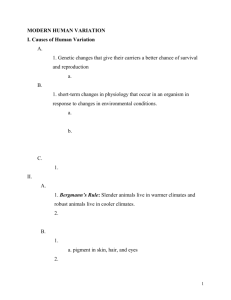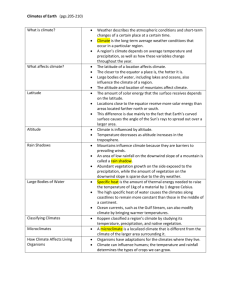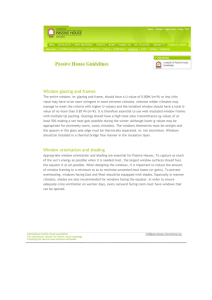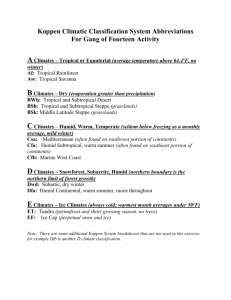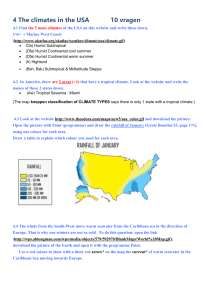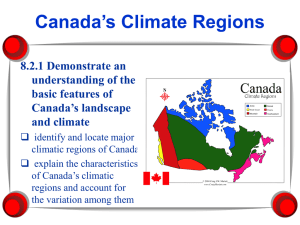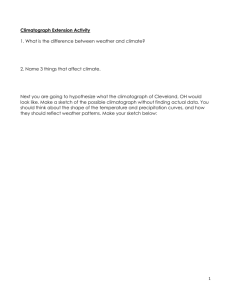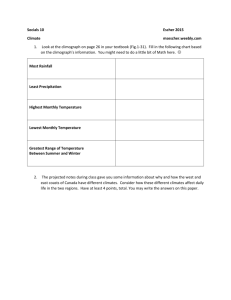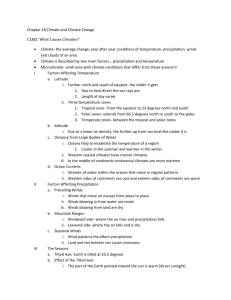Köppen climate classification
advertisement
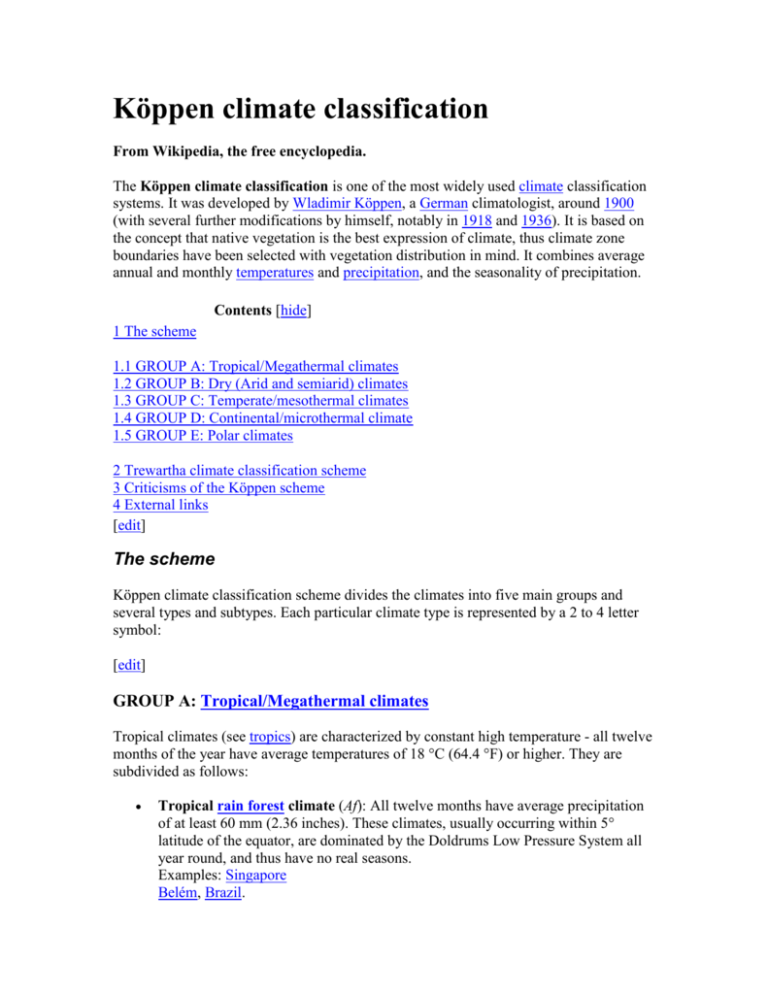
Köppen climate classification
From Wikipedia, the free encyclopedia.
The Köppen climate classification is one of the most widely used climate classification
systems. It was developed by Wladimir Köppen, a German climatologist, around 1900
(with several further modifications by himself, notably in 1918 and 1936). It is based on
the concept that native vegetation is the best expression of climate, thus climate zone
boundaries have been selected with vegetation distribution in mind. It combines average
annual and monthly temperatures and precipitation, and the seasonality of precipitation.
Contents [hide]
1 The scheme
1.1 GROUP A: Tropical/Megathermal climates
1.2 GROUP B: Dry (Arid and semiarid) climates
1.3 GROUP C: Temperate/mesothermal climates
1.4 GROUP D: Continental/microthermal climate
1.5 GROUP E: Polar climates
2 Trewartha climate classification scheme
3 Criticisms of the Köppen scheme
4 External links
[edit]
The scheme
Köppen climate classification scheme divides the climates into five main groups and
several types and subtypes. Each particular climate type is represented by a 2 to 4 letter
symbol:
[edit]
GROUP A: Tropical/Megathermal climates
Tropical climates (see tropics) are characterized by constant high temperature - all twelve
months of the year have average temperatures of 18 °C (64.4 °F) or higher. They are
subdivided as follows:
Tropical rain forest climate (Af): All twelve months have average precipitation
of at least 60 mm (2.36 inches). These climates, usually occurring within 5°
latitude of the equator, are dominated by the Doldrums Low Pressure System all
year round, and thus have no real seasons.
Examples: Singapore
Belém, Brazil.
Some of the places that have this climate are indeed uniformly and monotonously
wet throughout the year (e.g., Andagoya, Colombia), but in many cases the period
of higher sun and longer days is distinctly wettest (as at Palembang, Indonesia) or
the time of lower sun and shorter days may have more rain (as at Sitiawan,
Malaysia).
A few places with this climate are found at the outer edge of the tropics, almost
exclusively in the Southern Hemisphere; one example is Santos, Brazil.
Tropical monsoon climate (Am): This type of climate, most common in southern
Asia and West Africa, results from the monsoon winds which change direction
according to the seasons. This climate has a driest month (which nearly always
occurs at or soon after the "winter" solstice for that side of the equator) with
rainfall less than 60 mm, but more than (100 - [total annual precipitation
{mm}/25]):
Examples: Conakry, Guinea
Chittagong, Bangladesh.
There is also another scenario under which some places fit into this category; this
is referred to as the trade-wind littoral climate because easterly winds bring
enough precipitation during the "winter" months to prevent the climate from
becoming a tropical wet-and-dry climate. Jakarta, Indonesia and Miami, Florida
are included among these locations.
Tropical wet and dry or savanna climate (Aw): These climates have a
pronounced dry season, with the driest month having precipitation less than 60
mm and also less than (100 - [total annual precipitation {mm}/25]):
Examples: Bangalore, India
Veracruz, Mexico
Townsville, Australia.
Most places that have this climate are found at the outer margins of the tropical
zone, but occasionally an inner-tropical location (e.g., San Marcos, Colombia)
also qualifies.
Sometimes As is used in place of Aw if the dry season occurs during the time of
higher sun and longer days. This is the case in parts of Hawaii (Honolulu), East
Africa (Mombasa, Kenya) and Sri Lanka (Trincomalee), for instance. In most
places that have tropical wet and dry climates, however, the dry season occurs
during the time of lower sun and shorter days.
[edit]
GROUP B: Dry (Arid and semiarid) climates
These climates are characterized by the fact that precipitation is less than potential
evaporation and transpiration. The threshold is determined as follows:
To find the precipitation threshold (in millimeters), multiply the average annual
temperature in °C by 20, then add 280 if 70% or more of the total precipitation is
in the high-sun half of the year (April through September in the Northern
Hemisphere, or October through March in the Southern), or 140 if 30%-70% of
the total precipitation is received during the applicable period, or 0 if less than
30% of the total precipitation is so received.
If the annual precipitation is less than half the threshold for Group B, it is
classified as BW (desert climate) - if it is less than the threshold but more than half
the threshold, it is classified as BS (steppe climate).
A third letter can be included to indicate temperature. Originally, h signified low
latitude climate (average annual temperature above 18 °C) while k signified
middle latitude climate (average annual temperature below 18 °C), but the more
common practice today (especially in the United States) is to use h to mean that
the coldest month has an average temperature that is above 0 °C (32 °F), with k
denoting that at least one month averages below 0 °C.
Examples: Yuma, Arizona (BWh)
Turpan, China (BWk)
Cobar, Australia (BSh)
Medicine Hat, Alberta (BSk).
Some desert areas, situated along the west coasts of continents at tropical or neartropical locations, are characterized by cooler temperatures than encountered
elsewhere at comparable latitudes (due to the nearby presence of cold ocean
currents) and frequent fog and low clouds, despite the fact that these places rank
among the driest on earth in terms of actual precipitation received. This climate is
sometimes labelled BWn and examples can be found at Lima, Peru and Walvis
Bay, Namibia.
On occasion, a fourth letter is added to indicate if either the winter or summer is
"wetter" than the other half of the year. To qualify, the wettest month must have
at least 60 mm of average precipitation if all twelve months are above 18 °C, or
30 mm (1.18 inches) if not; plus at least 70% of the total precipitation must be in
the same half of the year as the wettest month - but the letter used indicates when
the dry season occurs, not the "wet" one. This would result in Khartoum, Sudan
being reckoned as BWhw, Niamey, Niger as BShw, El Arish, Egypt as BWhs,
Asbi'ah, Libya as BShs, Umnugobi, Mongolia as BWkw, and Xining, China as
BSkw (BWks and BSks do not exist). If the standards for neither w nor s are met,
no fourth letter is added.
[edit]
GROUP C: Temperate/mesothermal climates
These climates have an average temperature above 10 °C (50 °F) in their warmest
months, and a coldest month average between -3 °C and 18 °C. (Some climatologists,
particularly in the United States, prefer to observe 0 °C rather than -3 °C in the coldest
month as the boundary between this group and Group D; this is done to prevent certain
headland locations in New England - principally Cape Cod - and such nearby islands as
Nantucket and Martha's Vineyard, from fitting into the Maritime Temperate category
noted below; this category is alternately known as the Marine West Coast climate, and
eliminating the aforementioned locations confines it exclusively to places found along the
western margins of the continents, at least in the Northern Hemisphere).
The second letter indicates the precipitation pattern - w indicates dry winters
(driest winter month average precipitation less than one-tenth wettest summer
month average precipitation; one variation also requires that the driest winter
month have less than 30 mm average precipitation), s inidicates dry summers
(driest summer month less than 30 mm average precipitation and less than onethird wettest winter month precipitation) and f means significant precipitation in
all seasons (neither above mentioned set of conditions fulfilled).
The third letter indicates the degree of summer heat - a indicates warmest month
average temperature above 22 °C (71.6 °F), b indicates warmest month average
temperature below 22 °C, with at least 4 months averaging above 10 °C, while c
means 3 or fewer months with mean temperatures above 10 °C.
The order of these two letters is sometimes reversed, especially by climatologists
in the United States.
Group C climates are subdivided as follows:
o Mediterranean climates (Csa, Csb): These climates usually occur on the
western sides of continents between the latitudes of 30° and 45°. These
climates are in the polar front region in winter, and thus have moderate
temperatures and changeable weather. Summers are hot and dry, due to
the domination of the subtropical high pressure systems, except in the
immediate coastal areas, where summers are cooler due to the nearby
presence of cold ocean currents.
Examples: Palermo, Sicily (Csa)
Gaziantep, Turkey (Csa)
Santiago, Chile (Csb)
Portland, Oregon (Csb).
o Humid Subtropical climates (Cfa, Cwa): These climates usually occur in
the interiors of continents, or on their east coasts, between the latitudes of
25° and 40°. Unlike the Mediterranean climates, the summers are humid
due to unstable tropical air masses, or onshore Trade Winds. In eastern
Asia, winters can be dry (and colder than other places at a corresponding
latitude) because of the Siberian high pressure system, and summers very
wet due to monsoonal influence.
Examples: Houston, Texas (Cfa - uniform precipitation distribution)
Brisbane, Australia (Cfa - summer wetter than winter)
Yalta, Ukraine (Cfa - summer drier than winter)
Luodian, China (Cwa).
o Maritime Temperate climates (Cfb, Cwb): Cfb climates usually occur on
the western sides of continents between the latitudes of 45° and 55°; they
are typically situated immediately poleward of the Mediterranean
climates, although in Australia this climate is found immediately poleward
of the Humid Subtropical climate, and at a somewhat lower latitude. These
climates are dominated all year round by the polar front, leading to
changeable, often overcast weather. Summers are cool due to cloud cover,
but winters are milder than other climates in similar latitudes.
Examples: Limoges, France (uniform precipitation distribution)
Langebaanweg, South Africa (summer wetter than winter)
o
Prince Rupert, British Columbia (summer drier than winter).
Cfb climates are also encountered at high elevations in certain tropical
areas, where the climate would be that of a tropical rain forest if not for
the altitude. Bogotá, Colombia is perhaps the best example.
Cwb is found only at higher altitudes, without which the climate would be
tropical wet and dry; examples include Addis Ababa, Ethiopia and Mexico
City.
Maritime Subarctic climates (Cfc): These climates occur poleward of the
Maritime Temperate climates, and are confined either to narrow coastal
strips on the western poleward margins of the continents, or, especially in
the Northern Hemisphere, to islands off such coasts.
Examples: Punta Arenas, Chile (uniform precipitation distribution)
Monte Dinero, Argentina (summer wetter than winter)
Tórshavn, Faroe Islands (summer drier than winter).
[edit]
GROUP D: Continental/microthermal climate
These climates have an average temperature above 10 °C in their warmest months, and a
coldest month average below -3 °C (or 0 °C in some versions). These usually occur in the
interiors of continents, or on their east coasts, north of 40° North latitude. Group D
climates do not exist at all in the Southern hemisphere due to the smaller land masses
here.
The second and third letters are used as for Group C climates, while a third letter
of d indicates 3 or fewer months with mean temperatures above 10 °C and a
coldest month temperature below -38 °C (-36.4 °F).
Group D climates are subdivided as follows:
o Hot Summer Continental climates (Dfa, Dwa, Dsa) - Dfa climates
usually occur in the forties latitudes, and in eastern Asia Dwa climates
extend further south due to the influence of the Siberian high pressure
system, which also causes winters here to be dry, and summers can be
very wet because of monsoon circulation.
Examples: Lowell, Massachusetts (Dfa - uniform precipitation
distribution)
Peoria, Illinois (Dfa - summer wetter than winter)
Santaquin, Utah (Dfa - summer drier than winter)
Beijing, China (Dwa).
Dsa exists only at higher elevations adjacent to areas with Mediterranean
climates, such as Cambridge, Idaho and Saqqez in Iranian Kurdistan.
o Warm Summer Continental climates (Dfb, Dwb, Dsb) - Dfb and Dwb
climates are immediately north of Hot Summer Continental climates, and
also in central and eastern Europe, between the Maritime Temperate and
Continental Subarctic climates.
Examples: Moncton, New Brunswick (Dfb - uniform precipitation
o
o
distribution)
Minsk, Belarus (Dfb - summer wetter than winter)
Revelstoke, British Columbia (Dfb - summer drier than winter)
Rudnaya Pristan, Russia (Dwb).
Dsb arises from the same scenario as Dsa, but at even higher altitudes, and
chiefly in North America since here the Mediterranean climates extend
further poleward than in Eurasia; Mazama, Washington is one such
location.
Continental Subarctic or Taiga climates (Dfc, Dwc, Dsc) - Dfc and Dwc
climates occur poleward of the other Group D climates, mostly north of
50° North latitude.
Examples: Sept-Îles, Quebec (Dfc - uniform precipitation distribution)
Anchorage, Alaska (Dfc - summer wetter than winter)
Mount Robson, British Columbia (Dfc - summer drier than winter)
Irkutsk, Russia (Dwc).
Dsc, like Dsa and Dsb, is confined exclusively to highland locations near
areas that have Mediterranean climates, and is the rarest of the three as a
still higher altitude is needed to produce this climate. Example: Galena
Summit, Idaho.
Continental Subarctic climates with extremely severe winters (Dfd,
Dwd): These climates occur only in eastern Siberia. The names of some of
the places that have this climate - most notably Verkhoyansk and
Oymyakon - have become veritable synonyms for extreme, severe winter
cold.
[edit]
GROUP E: Polar climates
These climates are characterized by average temperatures below 10 °C in all twelve
months of the year:
Tundra climate (ET): Warmest month has an average temperature between 0 °C
and 10 °C. These climates occur on the northern edges of the North American and
Eurasian landmasses, and on nearby islands; they also exist along the outer
fringes of Antarctica (especially the Palmer Peninsula) and on nearby islands.
Examples: Iqaluit, Nunavut
Provideniya, Russia
Deception Island, Antarctica.
ET is also found at high elevations outside the polar regions, above the timber line
- as at Mount Washington, New Hampshire.
Ice Cap climate (EF): All twelve months have average temperatures below 0 °C.
This climate is dominant in Antarctica (e.g., Scott Base) and in inner Greenland
(e.g., Eismitte).
Occasionally, a third, lower-case letter is added to ET climates if either the
summer or winter is clearly drier than the other half of the year; thus Qikiqtaruk,
or Herschel Island, off the coast of Canada's Yukon Territory, becomes ETw, with
Pic du Midi de Bigorre in the French Pyrenees acquiring an ETs designation. If
the precipitation is more or less evenly spread throughout the year, ETf may be
used, such as for Hebron, Labrador. When the option to include this letter is
exercised, the same standards that are used for Groups C and D apply, with the
additional requirement that the wettest month must have an average of at least 30
mm precipitation (Group E climates can be as dry or even drier than Group B
climates based on actual precipitation received, but their rate of evaporation is
much lower). Seasonal precipitation letters are almost never attached to EF
climates, mainly due to the difficulty in distinguishing between falling and
blowing snow, as snow is the sole source of moisture in these climates.
[edit]
Trewartha climate classification scheme
The Trewartha climate classification scheme is a modified version of the Köppen system.
It attempts to redefine the broad climatic groups in such a way as to be closer to
vegetational zoning.
Group A: This the tropical climate group, defined the same as in Köppen's
scheme (i.e., all 12 months average 18 °C or above). Climates with no more than
2 dry months (defined as having less than 60mm average precipitation, same as
per Köppen) are classified Ar (instead of Köppen's Af), while others are classified
Aw if the dry season is at the time of low sun/short days or As if the dry season is
at the time of high sun/long days. There was no specific monsoon climate
identifier in the original scheme, but Am was added later, with the same
parameters as Köppen's (except that at least three months, rather than one, must
have less than 60mm average precipitation).
Group B: BW and BS mean the same as in the Köppen scheme, with the Köppen
BWn climate sometimes being designated BM (the M standing for "marine").
However, a different formula is used to quantify the aridity threshold: 10 X (T 10) + 3P, with T equalling the mean annual temperature in degrees Celsius and P
denoting the percentage of total precipitation received in the six high-sun months
(April through September in the Northern Hemisphere and October through
March in the Southern). If the precipition for a given location is less than the
above formula, its climate is said to be that of a desert (BW); if it is equal to or
greater than the above formula but less than twice that amount, the climate is
classified as steppe (BS); and if the precipitation is more than double the value of
the formula the climate is not in Group B. Unlike in Köppen's scheme, no thermal
subsets exist within this group in Trewartha's, unless the Universal Thermal Scale
(see below) is used.
Group C: In the Trewartha scheme this category encompasses subtropical
climates only (8 or more months above 10 °C). Cs and Cw have the same
meanings as they do in Köppen's scheme, but the subtropical climate with no
distinct dry season is designated Cr instead of Köppen's Cf (and for Cs the
average annual precipitation must be less than 890mm [35 inches] in addition to
the driest summer month having less than 30mm precipitation and being less than
one-third as wet as the wettest winter month).
Group D: This group represents temperate climates (4 to 7 months above 10 °C).
Maritime temperate climates (most of Köppen's Cfb and Cwb climates, though
some of these would fit into Trewartha's Cr and Cw respectively) are denoted DO
in the Trewartha classification (although some places near the east coasts of both
North America and Asia actually qualify as DO climates in Trewartha's scheme
when they fit into Cfa/Cwa rather than Cfb/Cwb in Köppen's), while continental
climates are represented as DCa (Köppen Dfa, Dwa, Dsa) and DCb (Köppen Dfb,
Dwb, Dsb). For the continental climates, sometimes the third letter (a or b) is
omitted and DC is simply used instead, and occasionally a precipitational
seasonality letter is added to both the maritime and continental climates (r, w, or
s, as applicable). The dividing point between the maritime and continental
climates is 0 °C in the coldest month, rather than the Köppen value of -3 °C (as
noted in the section on the Köppen scheme, however, some climatologists particularly in the United States - now observe 0 °C in the coldest month as the
equatorward limit of the continental climates in that scheme as well).
Group E: This represents subarctic climates, defined the same as in Köppen's
scheme (1 to 3 months with average temperatures of 10 °C or above; Köppen Cfc,
Dfc, Dwc, Dsc, Dfd, Dwd). In the original scheme, this group was not further
divided; later, the designations EO and EC were created, with EO (maritime
subarctic) signifying that the coldest month averages above -10 °C, while EC
(continental subartctic or "boreal") means that at least one month has an average
temperature of -10 °C or below. As in Group D, a third letter can be added to
indicate seasonality of precipitation. There is no separate counterpart to the
Köppen Dfd/Dwd climate in Trewartha's scheme.
Group F: This is the polar climate group, split into FT (Köppen ET) and FI
(Köppen EF).
Group H: Highland climates, in which altitude plays a role in determining
climate classification. Specifically, this would apply if correcting the average
temperature of each month to a sea-level value using the formula of adding 5.6°C
for each 1,000 meters of elevation would result in the climate fitting into a
different thermal group than that into which the actual monthly temperatures
place it. Sometimes G is used instead of H if the above is true and the altitude is
500 meters or higher but lower than 2,500 meters; but the G or H is placed in
front of the applicable thermal letter rather than replacing it - and the second letter
used reflects the corrected monthly temperatures, not the actual monthly
temperatures.
Universal Thermal Scale: An option exists to include information on both the
warmest and coldest months for every climate by adding a third and fourth letter,
respectively. The letters used conform to the following scale:
i - severely hot: Mean monthly temperature 35 °C or higher
h - very hot: 28 to 34.9°C
a - hot: 23 to 27.9°C
b - warm: 18 to 22.9°C
l - mild: 10 to 17.9°C
k - cool: 0.1 to 9.9°C
o - cold: -9.9 to 0 °C
c - very cold: -24.9 to -10 °C
d - severely cold: -39.9 to -25 °C
e - excessively cold: -40 °C or below.
Examples of the resulting designations include Afaa for Kuala Lumpur, Malaysia,
BWhl for Aswan, Egypt, Crhk for Dallas, Texas, DOlk for London, England, EClc
for Arkhangelsk, Russia, and FTkd for Barrow, Alaska.
[edit]
Criticisms of the Köppen scheme
Some climatologists have argued that Köppen's system could be improved upon. One of
the most frequently-raised objections concerns the temperate Group C category, regarded
by many as overbroad (it includes both Tampa, Florida and Cape May, New Jersey, for
example). In Applied Climatology (first edition published in 1966), John Griffiths
proposed a new subtropical zone, encompassing those areas with a coldest month of
between 6 °C (42.8 °F) and 18 °C, effectively subdividing Group C into two nearly equal
parts (his scheme assigns the letter B to the new zone, and identifies dry climates with an
additional letter immediately following the temperature-based letter).
Another point of contention involves the dry B climates; the argument here is that their
separation by Köppen into only two thermal subsets is inadequate. Those who hold this
view (including Griffiths) have suggested that the dry climates be placed on the same
temperature continuum as other climates, with the thermal letter being followed by an
additional capital letter - S for steppe or W (or D) for desert - as applicable.
A third idea is to create a maritime polar or EM zone within Group E to separate
relatively mild marine locations (such as Ushuaia, Argentina and the outer Aleutian
Islands) from the colder, continental tundra climates. Specific proposals vary; some
advocate setting a coldest-month parameter, such as -7 °C (19.4 °F), while others support
assigning the new designation to areas with an average annual temperature of above 0 °C.
The accuracy of the 10 °C warmest-month line as the start of the polar climates has also
been questioned; Otto Nordenskiöld, for example, devised an alternate formula: W = 9 0.1 C, with W representing the average temperature of the warmest month and C that of
the coldest month, both in degrees Celsius (for instance, if the coldest month averaged 20 ° C, a warmest-month average of 11 °C or higher would be necessary to prevent the
climate from being polar). This boundary does appear to more closely follow the tree
line, or the latitude poleward of which trees cannot grow, than the 10 °C warmest-month
isotherm; the former tends to run poleward of the latter near the western margins of the
continents, but at a lower latitide in the landmass interiors, the two lines crossing at or
near the east coasts of both Asia and North America.
Tropics
From Wikipedia, the free encyclopedia.
(Redirected from Tropical)
The tropics are the geographic region of the Earth centered on the equator and limited in
latitude by the two tropics: the Tropic of Cancer in the north and the Tropic of Capricorn
in the southern hemisphere.
This area lies approximately between 23.5° N latitude and 23.5° S latitude, and includes
all the parts of the Earth where the sun reaches a point directly overhead at least once
during the solar year (north of the Tropic of Cancer and south of the Tropic of Capricorn
the sun never reaches an azimuth of 90° or directly overhead). The word "tropics" comes
from Greek tropos meaning "turn", because the apparent position of the Sun oscillates
between the two tropics with a period which we call a year.
Tropical plants and animals are those species native to the tropics. Tropical is also
sometimes used in a general sense of a place that is warm and moist year-round, often
with the sense of lush vegetation. However, there are places in the tropics that are
anything but "tropical" in this sense, even with alpine tundra and snow-capped peaks!
(See, for example, Mauna Kea).
In Köppen's scheme of climate classification, a tropical climate is defined as a non-arid
climate in which all twelve months have mean temperatures above 18 °C (64.4 °F).
